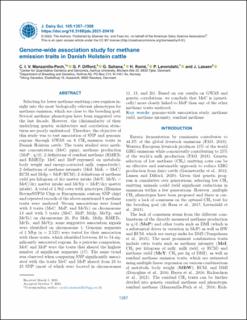| dc.description.abstract | Selecting for lower methane emitting cows requires insight into the most biologically relevant phenotypes for methane emission, which are close to the breeding goal. Several methane phenotypes have been suggested over the last decade. However, the (dis)similarity of their underlying genetic architecture and correlation structures are poorly understood. Therefore, the objective of this study was to test association of SNP and genomic regions through GWAS on 8 CH4 emission traits in Danish Holstein cattle. The traits studied were methane concentration (MeC; ppm), methane production (MeP ; g/d), 2 definitions of residual methane (RMETc and RMETp: MeC and MeP regressed on metabolic body weight and energy-corrected milk, respectively), 2 definitions of methane intensity (MeI; MeIc = MeC/ECM and MeIp = MeP/ECM); 2 definitions of methane yield per kilogram of dry matter intake (MeY; MeYc = MeC/dry matter intake and MeYp = MeP/dry matter intake). A total of 1,962 cows with genotypes (Illumina BovineSNP50 Chip or Eurogenomic custom SNP chip) and repeated records of the above-mentioned 8 methane traits were analyzed. Strong associations were found with 3 traits (MeC, MeP, and MeYc) on chromosome 13 and with 5 traits (MeC, MeP, MeIp, MeYp, and MeYc) on chromosome 26. For MeIc, MeIp, RMETc, MeYc, and MeYp, some suggestive association signals were identified on chromosome 1. Genomic segments of 1 Mbp (n = 2,525) were tested for their association with these traits, which identified between 33 to 54 significantly associated regions. In a pairwise comparison, MeC and MeP were the traits that shared the highest number of significant segments (17). The same trend was observed when comparing SNP significantly associated with the traits MeC and MeP shared from 23 to 25 SNP (most of which were located in chromosomes 11, 13, and 26). Based on our results on GWAS and genetic correlations, we conclude that MeC is (genetically) more closely linked to MeP than any of the other methane traits analyzed. | |
